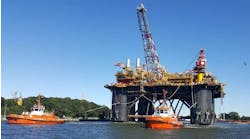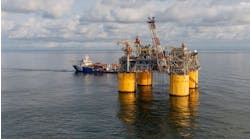Victor Schmidt
Houston
In the blink of an eye
The oil world breathed a sigh of relief this month as the race to the bottom by Saudi Arabia and Venezuela found a solution involving Mexico and Norway. Venezuela "blinked" in March allowing market discipline to kick-in at $12.80 per barrel for WTI. The collapse of producer's economies was averted and non-OPEC countries helped win the day.The regional competition flared into a problem last year that affected the wider market. According to the International Energy Agency, the oil markets in 1998 are affected by four basic differences, compared to 1997:
- High inventory levels
- Unreliable Asian demand
- Difficult market for OPEC crude
- Potential major increase in Iraqi exports.
Number watching production cuts
Saudi Arabia has been cajoling both OPEC and non-OPEC producers for years to apply discipline, ease crude oil production, and support a higher market price. Since last October the allure of the marginal penny won the day and filled the world's storage tanks with "cheap" oil. The new agreement trims 1.6-1.8 million b/d from the market. According to Smith Barney/Salomon Brothers, production cuts by country include: Saudia Arabia - 300,000 b/d; Venezuela - 200,000 b/d; Iran - 200,000 b/d; Nigeria - 125,000 b/d; Kuwait - 125,000 b/d; UAE - 125,000 b/d; Mexico - 100,000 b/d; Libya - 80,000 b/d; Indonesia - 70,000 b/d; Qatar - 50,000 b/d; Oman - 50,000 b/d; Algeria - 50,000 b/d; and Norway and all others - 100,000-320,000 b/d.Continuing cooperative moves by OPEC and non-OPEC producers will be required to preserve the market, fund the necessary long-range investment plans and avert a major shortfall in future supply once Southeast Asia's economies recover. Only the consumer wins an economic war-of-attrition.
Australia licensing round coming
The 1998 Release of Offshore Petroleum Exploration Areas is available from the Department of Primary Industries and Energy in Canberra. This year, 58 blocks are available:- 9 off Victoria and Tasmania
- 36 off Western Australia
- 12 off New Territories
- 3 off Queensland
Greenland drilling
The Fylla license, offshore western Greenland, will be drilled this summer by the West Odin. Site surveys will begin soon over several prospects. Phillips (operator), Statoil and Nunaoil and Dopas own the license.POSC seeks Russian standards
Petrotechnical Open Software Corp. (POSC) continues to spread the message of open communications between industry software systems worldwide. It has signed a Memorandum of Understanding with GlavNIVC and Pangea, which will create a joint project supporting the development and usage of POSC specifications in Russia.The goal of the project is to translate the basic POSC components into Russian so that a comparative analysis can be carried out with the Russian State Bank of the Digital Geodata (RSBGD) standards. The goal is to propose local Russian oil and gas requirements for the POSC data model, Epicentre. POSC, GlavNIVC and Pangea will be soliciting project support and participation from both oil and service companies. Contact POSC in Houston at Tel: (713) 784-1880 or Fax: (713) 784-9219.
Information age roils the world
The transition to an information economy is well along in the US, according to Roller Coaster 2000, a report on forces re-shaping daily life and work in America by Dr. Gregg Edwards and David Pearce Snyder. The crossover will occur around 2000, completing the transition from primarily labor-intensive to primarily information-intensive work. Full benefits will become evident over the next ten years.What is key in the report is the expectation that all industrial economies will be passing through this same techno-economic shift. This means that Europe and industrial Asia are facing the same painful transition that the US has endured. Countries farther down the development cycle will feel the distortions as well some time in the next century.
The oil industry rocketed into the information age after the 1986 price collapse forced major restructuring. It can thus serve as a model for countries and companies facing the transition. Astute energy companies will help their partners in industry and government learn from our first-adopter mistakes.
Copyright 1998 Oil & Gas Journal. All Rights Reserved.


